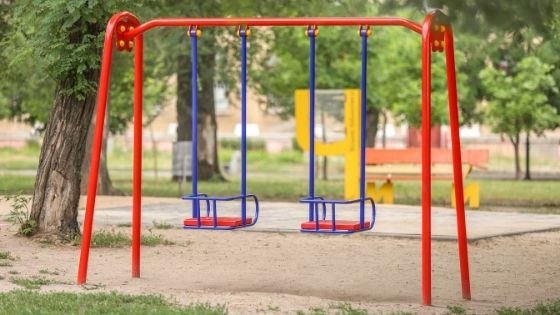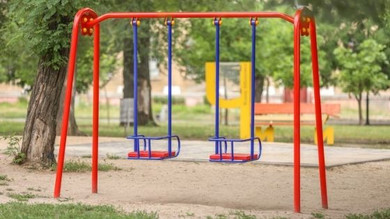
Choosing a suitable material to place underneath your swing set takes a lot of research. Some common playground materials are excellent choices, such as rubber mulch, but some come with a high price tag. Consider what to use for your playground swing area by looking over our comprehensive list of the different materials to place underneath a swing set.
What Exactly Can You Use?
When you’re thinking of what to place underneath playground fall zones, you have a few options. What exactly can you use is a fair question, rooted in a rather oddly specific item that you might not wonder about until after all areas of your community playground are built. On the other hand, when your child and their friends play on the swings, they'll enjoy jumping off from high heights. Instead of allowing them to jump into materials like dirt or rocks, consider a material like rubber mulch. Rubber mulch is easier to fall into without causing a child to endure the pain of splinters or scrapes.
Rubber Mulch Under Swing Sets
As mentioned in the above section, rubber mulch is the best material to use; as a child jumps from the swing, they'll fall right into a pile of rubber, absorbing shock and helping them feel secure once they make contact with the ground. However, even though rubber mulch is an excellent material to use, there are pros and cons to it.
Pros of Rubber Mulch
- Rubber mulch is environmentally friendly. Typically made from recycled tires, the material takes years to break down and won't need to be replaced.
- There's a wide variety of colors to pick from, and if you're feeling creative, consider getting rubber mulch in varying shades to create a rainbow for children to jump in.
- The greatest thing about rubber mulch is that it is resistant to bug infestations. In other words, you won’t need to worry about bugs invading the area.
Cons of Rubber Mulch
- Rubber mulch comes at a high initial cost.
- Unfortunately, this material is flammable, which means if you’re looking to be cautious with the type of material you purchase for your playground, it’s wise to go with an alternative.
- Depending on the form of rubber mulch, it’s not all going to be rock solid. As a safety precaution, make sure your child does not put this material in their mouth, as they can choke on the pieces.
Are There Alternatives To Rubber Mulch?
Yes, there is more than one option for rubber mulch alternatives. Although rubber mulch is a better product, it can still run you off your budget and become a significant safety issue if people are not careful with supervising children around this material type. Even though these different choices aren't as good, they're smart options if you're looking for something more affordable.
Loose Materials Below Swing Sets
Loose-fill materials can be a more budget-friendly option of what to place underneath your swing set. When you think of a swing set, loose material like sand or gravel often comes to mind. Here are some of the better loose-fill materials you can use for your playground area.
Wood Chips or Mulch for Your Swing Set
What advantages does mulch offer over rubber? Mulch is the second most common item to use under a swing set. It’s cheaper and more natural to use compared to other alternatives. Aside from rubber mulch, regular wood chips or mulch are eco-friendlier options for your swing set.
Although this material is eco-friendly, your children will experience fragments when jumping off and landing in the mulch. Again, as we stated above, the same choking hazard issue comes into play for rubber mulch. To prevent your children from placing these chips into their mouths, choose a different material.
Pea Gravel Under Swing Sets
Typically, you'd find pea gravel in someone's garden or at a dog park. Often, you might even see some scattered throughout playgrounds and other areas where people congregate. Fact in check, pea gravel is not the same as crushed stone since pea gravel is smaller and is a mix of stone fragments that are smaller and softer to the touch. If you're looking for shock absorption, gravel is the best choice.
Even though it can break a child's fall, pea gravel can become a choking hazard. So, when selecting material, ensure that you make families aware this material is a choking hazard and allow their children to play in the area with caution.
Sand Under Swing Sets
Sand is another common material often used underneath swing sets. Sand is a material that's widely used and played with among children at the park. It can help absorb shock reasonably well, but one of the significant downsides is that it can hide things like glass or personable items. Avoiding sharp objects is a precaution that needs to be taken seriously before installing sand under your swings.
Unitary Materials
There is another alternative that’s resistant to being kicked and dispensed into random areas of your park: unitary materials. Unitary materials are solids in the ground that hardly need any maintenance, quite similar to rubber mulch. Depending on the material you purchase, it can be expensive because of its longevity, and they require more money upfront to help install.
Pour in Place (PIP) Under Your Swings
A pour in place is another common material used for less maintenance. A pour in place has two layers of rubber to help with safety. The material has built-in shock absorption and is ADA-approved, so children with disabilities can enjoy playing on it.
Artificial Turf for Under the Swings
Synthetic turf is generally found on a soccer or football field. The turf is made of rubber infill that's made to imitate the appearance of grass. It's visible, and you won't need to worry about cutting it. Another plus is that bacteria exposure decreases, and you won't have to worry about wiping dirt off clothes. Ensure it is correctly installed before use.
Using this guide as navigation for the different materials to place underneath a swing set will be beneficial after purchasing your swing set parts from Discount Playground Supply. As soon as you buy the parts, you’ll be ready to dig in and find the best material for the underbelly of your swing set.


